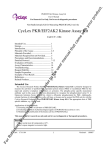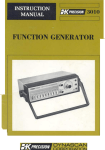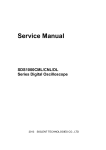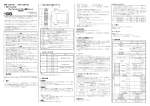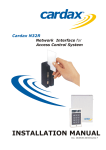Download phillips_pm 3264 - Micro Precision Calibration
Transcript
~ Advanceddisplay facilities for realtimeanalysis up -cc,to 100MHz Multi-sourcetriggering '.""'cc' ~ c c c Trigger view as fifth channel -".,- Simultaneousdisplay of MTBand DTB Portable with battery operation for field use c --" The PM 3264 offers a unique solution to many timing problems in digital electronics. Simultaneous display of 4 or 5 input signals pro'.:' i "C! quick and convenient method for reCiI:!; :n:llysis of digital signals both at component and system level. A versatile deflection system provides many user-benefits. For example, any combination of up to five input signals and two different modes can be selected by pushbuttons. The sensitivity of the channels includes 2mV/div up to 400V per screen, using the standard 1 : 10 attenuator probes. A flf-!:';';' t'iggering system allows the main an, -, ,-,j time bases to be triggered inderJ'3n::Jently by any of the four input channels. Also, an external trigger and composite trigger are provided. The alternate time base facility permits a quick reference for magnified displays with respect to the original waveform. The multiple trace display demands a CRT with very high light output. Philips has designed a sr; , c;1t!Jbe with 17kV pda which provides 'a i:: '",n-adequate sharp, bright, spot. With ai, lne foregoing facilities, the PM 3264 remains a typically compact, portable, oscilloscope which is also extremely simple to use. The various facilities are summarized as follows: 8 ff',." :I,annels to show signal relationSh,;: :ime 8 n1uiti-soufce triggering to add display and the original four channels to give a 12-trace display. Trigger view PM 3264 features the ultimate in multisourced triggering, with independent selection of main and delayed time bases from any of the four channels plus composite, line and external triggering on the maintime base. It is therefore essential that the relationship between the various displays and the triggering signal is always clear and this is provided by the trigger view facility.At flexibility 8 trigger-view to relate triggering directly to the four-channeldisplay the touch of a button the actualtrigger signal is displayed as a "fifth" channel, so that there can be no possibility of display . other features like differential displays ambiguity. and Com ' . , poslte triggering to extend per- formance 8 two time bases to allow signal detail to be plck~d QIJtfrom the data stream 8, "'!i,o,',ldtive time base mode to allow signal details to be directly related to data stream Moreover, facilities can be permutated. with virtually no limitation. For example, main and delayed time bases can be independently triggered from any of the four channels. Or the alternate time base mode can be employed with a differential display anyone of four channels to be displayed against an X-input signal or against any of the four vertical inputs. Composite triggering Single-channel triggering shows the exact relationship between the displayed signals. Composite triggering, however, allows signals that are not related in time or phase to be displayed and compared.This facility can be used in a variety of ways, for example rise times or waveform aberrations can be compared and measured regardless of the All channelscan be invertedand combinedfor obtaining differential displays. The oscillogram shows how noise is suppressed by addItion of two balanced signals displayed on channel A and -8, Alternate time base mode This mode is obtained simply by pushing both the main and delayed time base controls together. It enables the delayed time base signal details to be displayed at the same time as the intensified main time base signals. In this way signal details can be direct7yrelated to the data stream. x-v displays x-v displays are further evidence of the advanced display capability of the PM 3264. The independent triggering facilities allow Ti 0 Sf 51 b. m At :: :: Ac r, l 4-channel display with trigger view showing relationship of all signals to the external triggering source Note the high light output levels Fully independent triggering allows delayed time base to be set to trigger on channel A, which allows detailed .t investigation at any time base speed t time span between signals or the frequency CRT Logic triggering too The PM 3264 is the ideal compliment to a logic analyzer since it shows realtime relationships and signal details, such as glitches, in their actual, analog waveform. battery pack. In 0 Dl 81 M, relationship. Very easy operation PM 3264 is a highly sophisticated instrument but the front panel could not possibly be simpler or more logical. Channel selection is made, for example, directly above the relevant channel controls. Trigger selection ;or main and delayed time bases is also logically grouped. This simplifies and speeds up measurements and allows the oscil1oscope to be used for virtually all applications and production testing. In addition the PM 3264 is light, easy to transport and hence ideal for field work, a facility that can be extended via the optional I. Tr In L ... Type Philips rectangular domed mesh-type lube with 17kV acceleration potential and metal-backed phosphor Screen type P31 (GH phosphor standard) Useful screen area a x 10div of full centimeters Horizontal deflection can be obtained from either the main time base or the delayed time base or a combina. tion of the two, or from the signal source selected for X-deflection In this case X-V diagrams can be displayed using A, B, C, or D the EXT connector or the Line as a signal source Horizontal display modes - Main time base - Main time base intensltled by delayed time base Delayed time base Main time base and delayed time base simultaneously displayed (alternate) ouSly variable - X-Yoperation with X-deflection by AoSoCoD tine or Ext source HORIZONTAL AMPLIFIER Le 1m Ex Trl II Graticule Internal graticule with centimeter divisions and 2mm subdivisions along the central axes 10% and 90% lines are indicated.lliuminationcontinu- VERT/CAL ORYoM/SI - 51 + - Response E Tri DC AC Ex 1 t., DC 0 Hz..l00 MHz (35 MHz at 2mV) AC 7 Hz 100 MHz Respon',~ DC.2MHz (-3dB) Me 401 Risetime 35ns Deflection coefficient 50mV/div using EXT connector Un calibrated continuous control 1 : > 3. Tri! Be When A, B, C or Dare used, sensitivity is 2mV...5V/div DE Deflection coefficients 2mV5V/div In steps in 1-2-5 sequence Uncalibrated control between steps 1 : > 25 continuous Display modes - Channel Ao B, C or D - A + B, C + Do Trigger view any combination of these channels Multiple display chopped at1 MHz or Alternate Any channel may be inverted except Trigger view CMRR >1001 upto2MHz > 201at50MHz accuracy Yrl! Int. Fol TIt. Phase error 3' at 100kHz MAIN TIMEBASE MODES" '" c - Auto - Triggered (RC time 100ms) - Singleshot Time coefficient Input impedance 1 MO:t 2% in parallel with 15pFapprox. RC1ime,AC coupled 22ms Maximum input voltage 400VDC+ AGp" derating above 500kHz Maximum deflection Un distorted deflection range 1Sdiv. Measuring j:3% of 24div. up to 35MHz Shift Signal delay 15ns visible delay Trigger view Display: External or internal trigger signal Deflection coefficient external: 100 mV/div Trigger point: Screen centre :t 0.3div Time delay between vertical input and external input: 3ns 1s..50ns/dlv in 23 calibrated steps, in 1-2-5 sequence. Uncalibrated continuous control between steps (with UNCAL warning lamp should delayed time base be set out of calibration). x 10 magnifier extends max. sweep rate to 5ns/div. Accuracy :t 2% (+20°C..+30°C) :t 3% (+ 5"C+40°C) Additional error for magnifier :t 1% Ct Ca: 3V, Cal 6m Z-I Inp DC disi Inp 10k Variable hold-off Sweep hold-off time can be increased by a factor of 10 Me: 50\ QELAYEDTIMEBASE Ref 35r Modes Delayed time base starts, either immediately after the delay time or, upon arrival of the first trigger pulse after the delay time. PO Lln, AC DC Time coefficients O.5s..50ns/div. in 22 calibr~ted steps, 1-2-5 sequence. Uncalibrated continuous control between stepS, (with UNCAL warning lamp should main time base be set out of calibration). x 10 magnifier extends max. sweep rate to 5ns/div. Power consumption SOW at nominallin~ voltage Dimensions and weight (wxhxd) 316x 154 x 460mm (12.4 x 6.1.x18-in) 11kg (24Ib) ,.,~uracy .. of"(+20.C...+30.C) ~~Et!~A8IL/TIESj, ::3'/"(+ S.C...+4Q.C) Additional.error for magnifier:t 1% Calibrated sweep delay ContinuouS calibrated control between 0 and 10 x main time base setting. Incremental delay time accuracy 02% typical Ambient temperatures Delay time jitter Better than 1 :30 000 Rat~d range of use: Limits for operation: Storage and transport: -!ME BASE TRIGGERING +S.C to + 40.C -10.C to + SS.C -SS.C to + 7S.C Altitude Operating: to 5000rn (15 0001t) Non-operating: to 15 OOOrn(45 0001t) Ir'9g"r source 1nternalA, 8, C, D Composite, line, External Slope +or- Humidity 21 days cyclic damp heat 25.C...40.C R.H. 95% L8velr8ng~ Internal:24div External+ 1.2Vto - 12V 30g: half sinewave sl1ock af 11ms duration: 2 shocks per direction for a total of 12 shocks Trigger sensitivity --- 30MHz 100MHz - ---"", 1.5div OSdiv c -'.+ SOmV Ex! Trigger The environmental data is valid only if the instrument is checked in accordance with the official checking procedure. Details of these procedures and failure criteria are supplied on request by the PHILIPS organization in your country, or by PHILIPS TEST AND MEASUREMENT DEPARTMENT, EINDHOVEN, THE NETHERLANDS. Vlbratiol1 Vibrations in three directions with a maximum 01 15min per direction; 5...55 Hz and amplitude 010. 7mmp.pand 49 max acceleration Unit mounted on vibration table without shock absorb- 150mV --c """ ing material Recovery time Operates within 30 minutes coming from -100 C soak, going into 60% relative humidity at +200C room condi- coupling DC DC",full bandwidth AC: 100Hz ,lull bandwidth lions. Ext. trigger input impedance 1 M f! :t 2% in parallel with 15pF approx Maximum """ allowable input Electromagnetic interference Meets VDE 0871 and VDE 0875 voltage (Grenzwertklasse B) "cc +AC pk Safety Safety class I according to lEG 348 ;;'=-.,,;!rjltter Bailer than OSns -~ - - --~- D-~~~EP_TI':1~ ~~~~!!!~G~~'YG,j," Trigger source Internal A, B, C or 0 For Slope, Level range and Sensitivity TIME BASE TRIGGERING see MAIN CAUBRATION Front cover with storage space Operating and service manual BNC-banana adapter Contrast filter 4 x 10: 1 attenuator probe PM 8928/00 Collapsible viewing hood Cal terminal - BNC adapter options Universal Euro 220V/16A Option 001 North American 120V/15A Option 003 United Kingdom 240V/15A Option 004 PM 8924/00 Passiveprobe 1: 1 (1.5m) current 6mAp.p:t 2% square wave PM 8924/20 PM 8931/00 Input TTLcompatible. Passive probe 1 : 1 (2.5m) PM 8928/00 HFpassiveprobe10:1 (1.5m) ?-~ODUI:.ATION DC-coupled. display 100MHz oscilloscope Power options: Philips oscilloscopes are normally delivered in accordance with local power requirements. If an alternative power option is required. the instrument can be supplied fitted with a different power setting and power cord option. In such cases, purchase orders should specify one of the following OPTIONAL ACCESSORIES ';,.-,-ated voltage 3":0' '" 1% square wave Calibrated ACCESSORIES SUPPLIED PM 3264 "HIGH" levelbianksthe Passive probe 100: 1; 2pF (1.5m) PM 8960103 19-in rackmount ~dapter PM 9381 Oscilloscope camera PM 9366 Collapsible viewing hood ;"""t impedance Maximum 50V input voltage Response 35ns lime POWER Line voltages and frequencies AC 100..127V and 220 240V. 46.440Hz )C250350V PM 8980 PM 8991 Oscilloscope PM 8992/66 Accessory pouch PM 8999 Stand trolley ;,;",... c~



